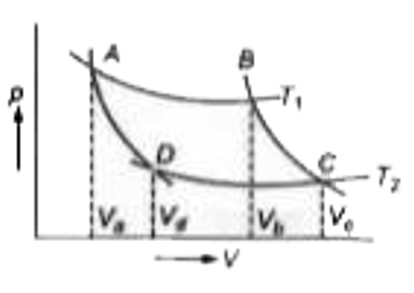From two stations A and B, two trains started simultaneously towards each other with velocities v1andv2 respectively. After they crossed each other the first train reached B in time t1 and the second train reached A in time t2. Show that v1:v2=sqrt(t_(2)):sqrt(t_(1))Solution in Bengali
Let the two trains crossed each other at point O after time t. So,
AO = v1 t and BO = v2ti.e,AOBO=v1v2
Again for the first train OB = v1t1
and for the second train OA = v2t2
∴ OAOB=AOBO=v2t2v1t1
Then v1v2=v2t2v1t1 or,v21v22=t2t1 or,v1v2=√t2√t1
Topper's Solved these Questions
- ONE - DIMENSIONAL MOTION BOOK - CHHAYA PUBLICATIONCHAPTER - ONE - DIMENSIONAL MOTION EXERCISE - Section Related Questions
17 Videos
- ONE - DIMENSIONAL MOTION BOOK - CHHAYA PUBLICATIONCHAPTER - ONE - DIMENSIONAL MOTION EXERCISE - HIGHER ORDER THINKING SKILL (HOTS) QUESTIONS
35 Videos
- NEWTONIAN GRAVITATION AND PLANETARY MOTIONBOOK - CHHAYA PUBLICATIONCHAPTER - NEWTONIAN GRAVITATION AND PLANETARY MOTIONEXERCISE - CBSE SCANNER
19 Videos
- QUESTION PAPERS OF NEET -2017BOOK - CHHAYA PUBLICATIONCHAPTER - QUESTION PAPERS OF NEET -2017EXERCISE - QUESTION
32 Videos
Similar Questions
Define rest and motion.
View SolutionCan a partical, moving with a uniform speed have a non-uniform velocity?
View SolutionWhat is the reason for absence of atmosphere in some planets?
View SolutionA molecule of a substance has permanent dipole moment p . A mole of this substance is polarised by applying a storg electrostatic field E . The direction of the field is suddenly changed of 60∘ . If N is the avogadro's number the amount of work done by the field is
View SolutionThe distance between two railwat stations A and B is 440 km. two trains T_(1) and T_(2) start simultaneously from the stations A and B , respectively , and move twards each other. Then train T_(1) and T_(2) start simultaneouslym from the station A and B respectively, and move towards each other. the train T_(1) moves with a constant speed of 60 km h^(-1) and the train T_(2) moves with a speed of 50 km h^(-1) , Determine the point where they meet and the time taken for this.
View Solutionयदि वस्तु समय t1 तक वेग v1 से तथा समय t2 तक वेग v2 से चले तो उसका औसत वेग होगा :
vav=v1t1+v2t2t1+t2
View SolutionA particle move with velocity v1 for time t1andv2 for time t2 along a straight line. The magntidue of its average acceleration is
View SolutionIf S1 is surface satellite and S2 is geostationary satellite, with time periods T1 and T2, orbital velocities V1 and V2
View SolutionTwo cars of same mass are moving with velocities v_(1) and v_(2) respectively. If they are stopped by supplying same breaking power in time t_(1) and t_(2) respectively then (v_(1))/(v_(2)) is
View SolutionA partical traveIIing with uniform acceleration along a straight line has average velocities v_(1),v_(2) and v_(3) in successive time intervals t_(1),t_(2) and t_(3) respectively . Prove that, (v_(2)-v_(1))/(v_(3)-v_(2))=(t_(1)+t_(2))/(t_(2)+t_(3))
View SolutionTwo bodies having masses m1 and m2 are dropped from heights h1 and h2 respectively. They reach the ground after times t1 and t2 and strike the ground with velocities v1 and v2 respectively. Choose the correct relations from the following:
View Solutionएक समान त्वरण के साथ गतिमान एक कण के औसत वेग, v एवं क्रमिक समयान्तरालों क्रमशः t1,t2, t3 पर दिए गए है |(v1−v2)(v2−v3) का मान होगा
View SolutionA point moves with uniform acceleration and v_(1), v_(2) And v_(3) Any successive periods: t_(1),t_(2) or t_(3)
View SolutionThe velocities of sound in an ideal gas at temperature T1andT2 K are found to be V1andV2 respectively. If ther.m.s velocities of the molecules of the same gas at the same temperatures T1andT2 are v1andv2 respectively then
View Solutionदो ताप T1 व T2 पर रुद्वोष्म वक्र चित्रानुसार है, Vb/Vc. का मान होगा।

View Solution
